Unleash the Power of Color in Masonry
By Gary Milla
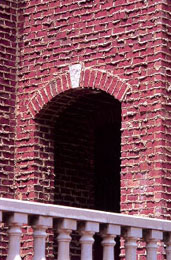 Artistic possibilities for achieving architectural variety and an upscale look in brick homes are endless thanks to colored mortar and varied finishing techniques. Discover how builders are using their imagination to increase masonry color schemes, as well as consumer interest.
Artistic possibilities for achieving architectural variety and an upscale look in brick homes are endless thanks to colored mortar and varied finishing techniques. Discover how builders are using their imagination to increase masonry color schemes, as well as consumer interest.
All the attributes that made brick popular thousands of years ago are the same qualities that keep people choosing this classic, durable and elegant building material for their homes today. According to surveys from the National Association of Home Builders (NAHB), brick homes are preferred by 60% of American homebuyers. Focus group research by the SouthWestern Brick Institute indicates that this strong preference for brick will continue. Builders predict that brick will remain the leading exterior finish material in mid- to higher-end homes.
Innovative design, durable products and high-quality craftsmanship are at the heart of homeowner satisfaction. Also, according to the NAHB surveys, consumers want to personalize their homes and live in neighborhoods with a mix of styles and prices. In the hands of talented masons and creative architects, colored masonry is a cost-effective strategy for creating the exact effects that buyers want and allowing builders to effectively differentiate their homes from competitive offerings. The difference is often enough to increase the perceived market value of a home and tip the scales toward a sale.
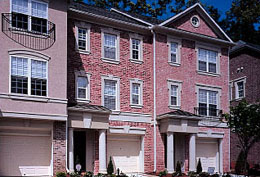 Debbie Naftel, Sales Manager at John Wieland Homes and Neighborhoods in Atlanta, often talks to prospective buyers who have driven through one of her communities and a competitor's development. "They know there's something different about the two," she says, "but they haven't a clue as to what the difference is."
Debbie Naftel, Sales Manager at John Wieland Homes and Neighborhoods in Atlanta, often talks to prospective buyers who have driven through one of her communities and a competitor's development. "They know there's something different about the two," she says, "but they haven't a clue as to what the difference is."
The difference between the neighborhoods is that Wieland communities use various shades of colored masonry in their homes. "We strive to have variety in our communities," Naftel says. "We vary the brick and the color of the mortar from house to house. It makes our streetscapes more compelling."
Keith Rogers, a builder of custom homes in the Winston-Salem, N.C., area, also uses colored masonry to achieve the overall aesthetic feel of the neighborhood and to differentiate one house from another.
"I can use the same brick in two houses right across the street from one another, and people never recognize it's the same brick because of the differences in mortar," he says.
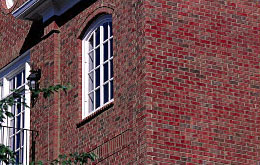 Roughly finished buff colored mortar, combined with weathered brick, creates a warm, comforting look. |
Builders are always considering new brick and mortar combinations to keep their home appearances fresh and distinctive. However, the artistic possibilities stemming from the myriad of colors, styles, textures and finishing techniques in creating the many unique looks for brick homes seem endless.
Faced with this challenge, builders have two choices:
- Specify a wide variety of bricks but risk creating a logistical nightmare and greater expense.
- Focus on mortar, rather than brick, to create subtle yet distinct personalities for homes.
Regina Sandlin, head of Trend Research and New Product Development at Signature Homes, a community home builder based in Birmingham, Ala., uses colored masonry as a sales tool. "We always try to get the look that people are drawn to when they see very expensive homes," she says. "We achieve an upscale look in our price point by using the colored mortars."
In some Signature Home communities, the homebuyer has a limited choice of brick colors and a wider choice of colored mortars. This helps the builder achieve economies of scale in brick purchases and rely on the colored masonry to create variety within the development.
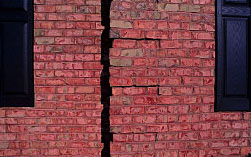 A red molded brick with matching mortar provides a monochromatic color scheme while maintaining a rustic look. |
In fact, with the seemingly endless array of mortar colors and varied finishing techniques available, the unique artistic expressions and upscale appearances of new brick homes may bear absolutely no resemblance to one another in style or architectural detailing.
The Power of Color in Developing Many Unique Looks
The color of the mortar can have a dramatic impact on the appearance of a house and effectively unify outdoor architectural elements such as walls, patios and fountains. When building a home that features exterior brick elements, Rogers chooses the same mortar color and same brick used in the house's facade to create a feeling that the courtyard is an extension of the house.
"The patios and walls give a real inside/outside orientation, and the colored mortar really makes a difference," he says.
Complementary or contrasting, colors of brick and joints create the wall's overall perceived color, and minor fluctuations in shade and texture impart depth and character. Extreme contrasts in the color of brick and mortar accentuate architectural details of the house, while paler shades of brick and mortar produce a monolithic look typically associated with Mediterranean architecture.
For custom builder Bryan Elliot, in Kernersville, N.C., colored masonry helps create a monolithic look as well as a high-contrast look. Elliot builds old-world style houses and uses various techniques to achieve that look.
"When I'm looking for a monolithic look, I'll use one of the taupe colors for the mortar, and get a brick to match because you don't see the mortar joints," he says. "It's a nice, clean look."
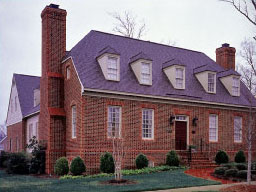 A Flemish bond, created by alternating stretcher and header units, is further highlighted by varying brick colors and using a light mortar color. |
Finishing Techniques Contribute to Final Appearance
Colored mortar isn't the only element that impacts visual elements. A wide variety of joint treatments, even the size of the joint, play a prominent role in the resulting look. Elliot often changes the type of joint the masons use because the mortar joint can seem to change the color of the brick and alter the total effect.
"For some homes, I use a flush joint on the brick with the colored masonry. It wipes the mortar up onto the brick so in the end you see more of the colored masonry than the brick," he says.
According to Sandlin, Signature Homes allows their buyers to get more personally involved in defining the look of their finished home by giving them a choice of brick color and mortar color, as well as a choice of masonry joint ? either a weeping joint or a full mortar smear.
About the Author
Gary Milla is Director of Specialty Products for Lafarge North America and is responsible for the company's masonry program in North America. Milla has a master's degree in engineering from the University of Waterloo and over 20 years of experience in the masonry industry.


















